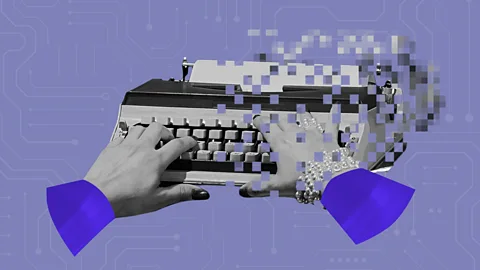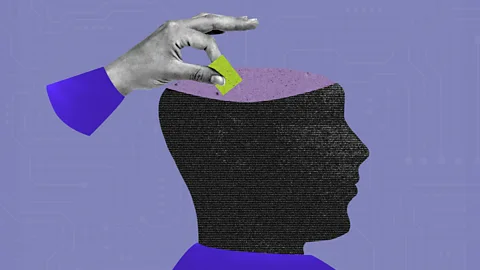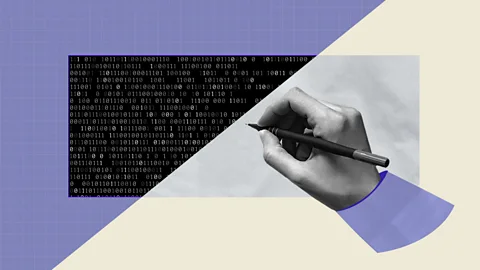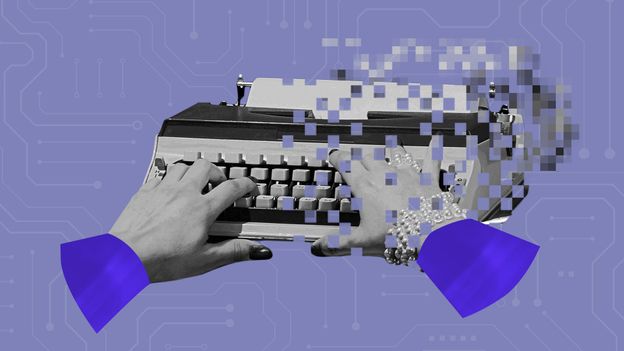 Serenity Strull/BBC/Getty Images
Serenity Strull/BBC/Getty ImagesIf you’re worried about how AI will affect your job, the world of copywriters may offer a glimpse of the future.
Writer Benjamin Miller – not his real name – was thriving in early 2023. He led a team of more than 60 writers and editors, publishing blog posts and articles to promote a tech company that packages and resells data on everything from real estate to used cars. “It was really engaging work,” Miller says, a chance to flex his creativity and collaborate with experts on a variety of subjects. But one day, Miller’s manager told him about a new project. “They wanted to use AI to cut down on costs,” he says. (Miller signed a non-disclosure agreement, and asked the BBC to withhold his and the company’s name.)
A month later, the business introduced an automated system. Miller’s manager would plug a headline for an article into an online form, an AI model would generate an outline based on that title, and Miller would get an alert on his computer. Instead of coming up with their own ideas, his writers would create articles around those outlines, and Miller would do a final edit before the stories were published. Miller only had a few months to adapt before he got news of a second layer of automation. Going forward, ChatGPT would write the articles in their entirety, and most of his team was fired. The few people remaining were left with an even less creative task: editing ChatGPT’s subpar text to make it sound more human.
By 2024, the company laid off the rest of Miller’s team, and he was alone. “All of a sudden I was just doing everyone’s job,” Miller says. Every day, he’d open the AI-written documents to fix the robot’s formulaic mistakes, churning out the work that used to employ dozens of people.
“Mostly, it was just about cleaning things up and making the writing sound less awkward, cutting out weirdly formal or over-enthusiastic language,” Miller says. “It was more editing than I had to do with human writers, but it was always the exact same kinds of edits. The real problem was it was just so repetitive and boring. It started to feel like I was the robot.”
Miller’s experience reflects a broader shift. In numerous industries, AI is being used to produce work that was once the exclusive domain of the human mind. AI is often less expensive than a person, but early adopters are quick to learn it can’t always perform on the same level. Now, people like Miller are finding themselves being asked to team up with the same robots that are stealing their jobs to give the algorithms a bit of humanity – a hidden army making AI seem better than it really is.
If AI gets dramatically more effective, this will be a temporary solution. If it doesn’t, Miller’s story could be a preview of what’s coming to other professions.
 Serenity Strull/BBC/Getty Images
Serenity Strull/BBC/Getty ImagesBut on a much smaller scale, some workers already face distressing consequences. If there’s one thing the large language models powered by generative AI can do, it’s string together words and paragraphs, putting some writers on the frontline.
The impact is already being felt among copywriters – the people who write marketing material and other content for businesses. In some corners of the copywriting business, AI is a blessing. It can be a useful tool that speeds up work and enhances creativity. But other copywriters, especially those early in their careers, say AI is making it harder to find jobs.
But some have also noticed a new type of gig is emerging, one that pays a lot less: fixing the robots’ shoddy writing.
“We’re adding the human touch, but that often requires a deep, developmental edit on a piece of writing,” says Catrina Cowart, a copywriter based in Lexington, Kentucky, US, who’s done work editing AI text.”The grammar and word choice just sound weird. You’re always cutting out flowery words like ‘therefore’ and ‘nevertheless’ that don’t fit in casual writing. Plus, you have to fact-check the whole thing because AI just makes things up, which takes forever because it’s not just big ideas. AI hallucinates these flippant little things in throwaway lines that you’d never notice.”
Cowart says the AI-humanising often takes longer than writing a piece from scratch, but the pay is worse. “On the job platforms where you find this work, it usually maxes out around 10 cents (£0.08) a word. But that’s when you’re writing, This is considered an editing job, so typically you’re only getting one to five cents (£0.008-£0.04) a word,” she says.
“It’s tedious, horrible work, and they pay you next to nothing for it,” Cowart says.
But for some in the copywriting world, whether the arrival of AI is a good or bad thing depends on how people approach it, and how far along people are in their careers. Some writers say working the tools into their creative process can even improve their work.
The American Writers and Artists Institute (AWAI), an organisation that offers training and resources for freelance writers, hosts a variety of courses on artificial intelligence for its members. AWAI president Rebecca Matter says AI classes are now the institute’s most popular offering by far. “It’s an incredible tool,” Matter says. “For people who make copywriting a career, the risk isn’t AI taking their jobs, it’s that they have to adapt. That can be uncomfortable, but I think it’s a huge opportunity.”
Matter says the transition to the AI world has been smooth for most of the writers she knows. In fact, it’s become such an inherent part of the copywriting process that many writers now add personal “AI policies” to their professional websites to explain how they use the technology.
Rebecca Dugas, a copywriter with nine years of experience, says AI has been a “godsend” that lets her turn out the same high-quality work in a fraction of the time.
“I use AI whenever my clients are comfortable with it,” she says. “Whether it’s brainstorming, market research, reworking paragraphs when I’m banging my head against the wall, it’s been an incredible co-creative partner.”

But Dugas understands that clients may have reservations about the technology. Her own AI policy explains that Dugas is happy to forgo AI for those who prefer it – but you can expect to pay more. The extra time and mental energy required means her AI-free projects come with a higher price tag.
As AI gets better, Dugas expects that some businesses will turn to ChatGPT and other tools for their writing needs instead of hiring human beings. “But I think even now we’re getting to the point where companies are realising that if you don’t understand copywriting, you can’t judge the effectiveness of what the AI produces,” she says. According to Dugas, that means there will always be well-paying work for talented, established writers.
But copywriters on the lower end of the career spectrum may not be so lucky. Today, many in that position find themselves in the middle of a distinctly modern set of contradictions.
A great deal of copywriting work comes from website owners who want articles that will generate more traffic from Google. However, Google made a number of dramatic announcements in the last year about its effort to remove “unhelpful” content from search results. That sparked fears that the tech giant may penalise websites that host AI-generated content. Google maintains that AI-writing is fine if the content is high quality, but these reassurances haven’t dissuaded concerns.
According to Cowart, many of the same freelance writing platforms that have AI detection software in place are simultaneously hiring people to edit content produced by chatbots. That means in some corners of the copywriting ecosystem, almost everything revolves around efforts to avoid the appearance of artificial intelligence.
“They’re selling AI content and paying you to fix it, and at the same time they’re sending you emails about how to write like a human so you don’t trigger their AI detector,” Cowart says. “It’s so insulting.” Worse, the detectors are regularly updated to keep up with ongoing changes from the companies who make AI chatbots, which means the rules about what might get your writing flagged as AI constantly shift. “It’s frustrating, because there are a million ways to say the same thing in English, but which one is more human? I don’t like the guessing,” she says.
Miller’s time humanising AI ended abruptly. After months of repetitive editing work, He got called in to an unexpected meeting. On 5 April 2024, the same day a historic earthquake shook his hometown of New York, he was laid off. The company decided that Miller was just another unnecessary layer of human intervention.
“I more or less got automated out of a job,” Miller says.
Fortunately, it wasn’t long before Miller found a new, if rather ironic, opportunity. He got a job at Undetectable AI, a technology company that builds software to make AI writing harder to identify. In other words, Miller is helping a company that’s using AI to do the work he was forced into after AI took his job in the first place.
Bars Juhasz, chief technology officer of Undetectable AI, says tools like the ones his company produces are certain to have some negative effects on the labour market, but he’s optimistic about the future of work. “When the automobile was first introduced in an era of horses and carts, people reacted like this was the end of days. But society always adapts,” Juhasz says. “I think we’re going to see a lot of jobs being replaced, and freelancers will be the hardest hit. I do feel for them. But these people who are getting paid to humanise AI are fantastic opportunists. Sure, it’s not a great job, but they have effectively recognised a new seat at a moment when we’re redefining the idea of productivity. People who can learn to work with the technology are going to be OK.”
Miller doesn’t look back fondly on his time in the AI-humanisation mines. “I contributed to a lot of the garbage that’s filling the internet and destroying it,” he says. “Nobody was even reading this stuff by the time I left because it’s just trash.” Ultimately, Miller assumes the company will just take down the AI articles he worked on. “It’ll be like it never even happened.”


